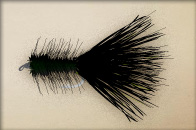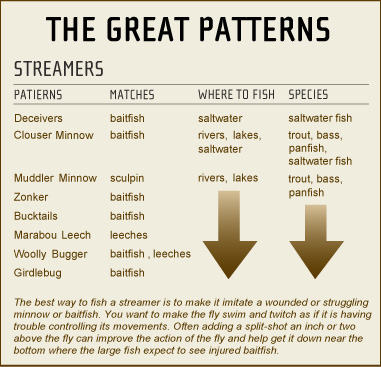Fly Fishing Streamers
The easiest way to catch a big fish on a fly is on a streamer. Since these fly fishing flies are designed to imitate small baitfish that larger fish feed on, many streamers tend to be larger than other types of flies. Learn what are some of the most common streamer fly patterns you can use.
Streamer Fishing Basic
 If you can cast 20 feet, you can catch fish in streams and rivers on fly fishing streamers. While streamer fishing, you can even strip line off the reel and into the water to let your streamer flies drift in the current and catch fish. The line swims the fly, making it look like a swimming baitfish. Cast fly fishing streamers such as Woolly Buggers into moving water and expect strikes from a hungry fish.
If you can cast 20 feet, you can catch fish in streams and rivers on fly fishing streamers. While streamer fishing, you can even strip line off the reel and into the water to let your streamer flies drift in the current and catch fish. The line swims the fly, making it look like a swimming baitfish. Cast fly fishing streamers such as Woolly Buggers into moving water and expect strikes from a hungry fish.
To improve the action, attach a split-shot to the leader just ahead of the fly and give the fly rod tip a bounce now and then as the streamer drifts downstream. The bounce of the tip causes the fly to jig up and down like a wounded minnow, and all gamefish are hunters for wounded baitfish.
Big saltwater or freshwater fly fishing streamers require bigger fly rods to cast: 7-weight, 8-weight or larger rods. The larger the fly, the larger the fish you'll catch and the larger the fly rod you'll need to cast and fight the fish (small flies can also catch large fish).
Bait Fish Fly Fishing Streamers
When planning to go streamer fishing, first determine which baitfish the larger fish feed on where you fish. For example, if you're fly fishing for bass in a stream and the bass there feed mostly on crayfish, you'll need a fly that looks like a crayfish. But if silver-colored minnows are their main food, then you'll want to use a silver minnow streamer.
While the fly line will swim the fly in moving water, it will not swim it in the still waters of ponds and lakes. There, you must swim the fly by casting and retrieving the fly. The farther you can cast, the longer your retrieve of the fly and the more fish you'll catch.
Different fly lines retrieve the fly at different levels in the water. For instance, a floating line will fish and retrieve the fly near the surface. But if the fish are deep, you need to get the fly deep to catch them. The best fly line for streamers in that instance is the use of a sinking line to get the fly down to the fish.
Fly Line Weight
Sinking lines are heavier than water. The heavier the line (Type 1 or I sinks slowest and Type 5 or V sinks fastest), the faster it sinks. In deep water or fast-moving water, you need a Type V line to reach bottom with the streamer. In slow-moving, shallow water, you need a floating line or a Type I. On lakes, an intermediate line or a Uniform Sinking line from Scientific Anglers are great for fly fishing streamers below the surface.
Fly fishing the streamer in ponds or lakes is simple - cast and retrieve it with a slow hand-twist retrieve or simply let it swing and follow behind the boat or float-tube as you move. The fish will do the rest.
When streamer fishing in streams, simply cast the streamer across the current and let the flow take it downstream. Most of your strikes will happen at the bottom of the swing. Cast the streamer toward the bank when fishing from a boat and retrieve it fast. Bass and trout will leap on it!
Other Fly Fishing Flies
Fly fishing streamers can serve you very well on the water when you’re aiming to catch larger fish. However, don’t forget about using other types of fly fishing flies, like dry flies and nymphs, to be able to catch the greatest variety of fish, as well. See the list of classic patterns for dry flies and nymphs in the below chart.

KEEP LEARNING

First Catch Center Trailer Gallery
FCC Trailer Photo Gallery
LEARN MORE

How to Tie a Duncan Knot
Learn to tie a Duncan knot by following these five simple steps. Watch our new video.
LEARN MORE

Welcome to Angler Academy!
No one said you can’t bring fishing inside! There’s lots of fun activities we can do right from home
LEARN MORE


.png?lang=en-US&ext=.png)